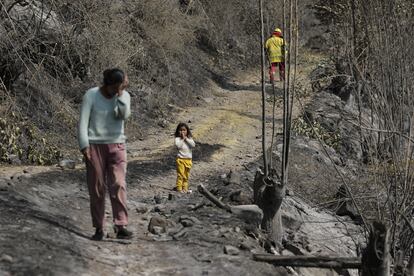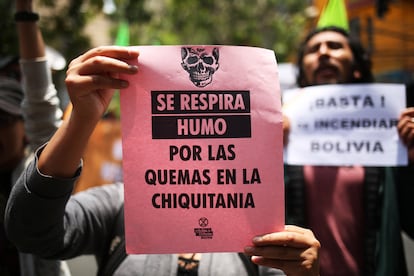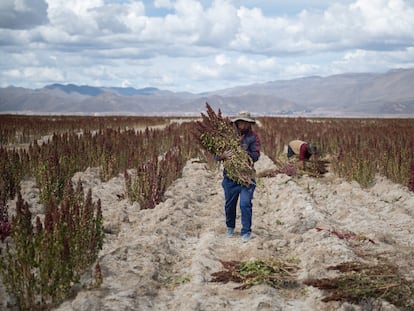Amid a severe drought, slash-and-burn fuels controversy in Bolivia
Most of the country’s wildfires start when farmers burn their fields to get ready for planting

Almost 6.7 million acres (2.7 million hectares) have been devastated by wildfires this year in Bolivia, a country that has been suffering for months from an intense drought that has affected urban water supplies and threatened vital farmlands. The fires are being blamed on a slash-and-burn practice called chaqueo — farmers cut down vegetation and burn it to clear the land and prepare the soil for planting. But these fires frequently rage out of control, causing extensive devastation.
In a hot and dry year like this one, recent fires covered major cities like Santa Cruz, La Paz, El Alto and Cochabamba in dense smoke and pollution, making life miserable for over seven million Bolivians. A red health alert was declared in Santa Cruz due to a 20% increase in respiratory disease cases in public hospitals. Similar measures were taken in La Paz and Beni, including a one-week suspension of school.

The fires aggravated pollution in the departmental capital of Santa Cruz, to the extent that on October 24, the city’s air had 313 micrograms per cubic meter (µg/m³) of pollutants. According to the international Air Quality Index (AQI) standard, this is classified as “extremely poor.” Santa Cruz’s AQI was worse than Beijing’s notoriously polluted air (185 µg/m³), and briefly had the most polluted air in the world.
In October, Bolivian authorities reported a total of 21 forest fires across four departments, devastating thousands of acres of farmland. Nearly 4,000 firefighters, police and soldiers were mobilized to combat the flames. The fires even reached Amboró National Park, a nature preserve in central Bolivia, where firefighters discovered approximately 50 acres (20 hectares) of coca fields. Illegal settlements were also found in Amboró, proof of Bolivian government neglect of the country’s protected natural resources.
According to the government forest and land agency (ABT), as of October 31, 16 people were being investigated for their alleged roles in three major fires around Santa Cruz, and four are being held in preventive detention. “All the fires were caused by humans,” said Mauricio Suárez, head of Beni’s early warning unit. Beni Department, in the heavily forested lowlands of northeastern Bolivia, has seen over 3.7 million acres (1.5 million hectares) ravaged by wildfires.

Slash-and-burn agriculture
The fires have also sparked debate about chaqueo, the controlled burning of fields by farmers at the end of the dry season. It’s a traditional practice to clear the land and add a nutrient-rich layer of ash, which makes the soil fertile. However, its effectiveness has been questioned in recent years, along with its negative environmental impacts and indiscriminate expansion of farmlands.
Much of the controversy revolves around regulations and measures by the Evo Morales administration (2006-2019) that provided benefits to both small farmers and large agro-industrial companies with a vested interest in expanding export crop cultivation. The regulations allowed the clearing of forests for agricultural purposes.
Santa Cruz Department has been the most heavily affected by the fires. This region, in eastern Bolivia, produces over 70% of the country’s food, per the Bolivian Institute of Foreign Trade (IBCE). Over the past 40 years, cultivated land has increased exponentially, from 654,335 acres (264,800 hectares) to over 7.4 million acres (3 million hectares), according to Tierra, a Bolivian foundation for sustainable rural development research and action.
Soybeans, the main crop in Santa Cruz, account for 97% of the national total and are the country’s third-largest export. In 2022, soybean exports generated over $2 billion in income. Meanwhile, deforestation in Santa Cruz has been on the rise, accounting for nearly 80% of the country’s deforestation. According to a report by Global Forest Watch (GFW), Bolivia ranked third in the world for primary forest loss in 2022, behind Brazil and the Democratic Republic of the Congo.
During the Morales administration, several measures were implemented to protect slash-and-burn practices. These measures included forgiving fines for illegal deforestation, and authorizing various methods of land clearing, such as the controlled burning of up to 50 acres (20 hectares) for agricultural and livestock activities on community or collective land. In addition, there was a focus on promoting responsible and controlled burning for effective fire management.
While deforestation for agriculture is permitted in designated areas of Santa Cruz and Beni, unauthorized clearing remains a punishable offense. Critics have raised concerns about these regulations amidst the recent wildfires, similar to ones that ravaged Chiquitania (Santa Cruz) and caused problems for Morales prior to the 2019 elections. “This type of discourse encourages and normalizes burning over two million hectares [five million acres] annually,” said Alcides Vadillo, director of the Tierra Foundation in Santa Cruz.
New settlements
Indigenous groups in Santa Cruz complain that these laws favor settlers from other areas who are encroaching on their ancestral lands and receiving farmland grants from the government. They blame the new settlers for forest fires that damage the ecosystems they have cherished for centuries. Morales himself once said chaqueo was the only tool impoverished people in rural areas had to avoid hunger.
“Large fires happen when new settlers encroach on the land and don’t know how to handle the burning. They just start fires anywhere and have no idea how to control them,” said Antonia Méndez, a resident of San Miguel de Velasco, a municipality in Santa Cruz heavily affected by the fires. “The fires get within a few kilometers of our town, and we fight to contain it. But when they get out of control, there’s just nothing we can do… The smoke and heat around here is getting unbearable.”
Méndez traveled to the departmental capital recently for the national meeting of Bolivia’s confederation of Indigenous women (CNAMIB). In response to the environmental disaster caused by intentional fires, the organization issued a resolution calling for the repeal of laws that allow chaqueo.
Yasin Peredo, a researcher with the Andean Communication and Development Center (CENDA), also says chaqueo by new settlers is having a significant impact on the country. “Since they are strategic allies of the government, they can easily obtain land. Chaqueo also benefits the agribusinesses that are always looking to expand.”
The Ministry of Autonomies in the Bolivian government oversees the distribution of powers among regional bodies, including departments, municipalities and autonomous indigenous governments. Vice Minister Álvaro Ruiz supports expediting the debate on rules regulating chaqueo to give citizens peace of mind. “If you have regulations that aren’t working, then you have to take drastic action,” he said.
Bolivia’s Legislative Assembly is now planning to reform the law on land burning. The proposed changes include increasing fines for illegal burning from $2 to $7 per hectare, and doubling the sentence for environmental crimes to eight years in prison. Despite recent rainfall and tireless firefighting efforts, the threat persists in Santa Cruz and La Paz as the relentless drought marches on.
Sign up for our weekly newsletter to get more English-language news coverage from EL PAÍS USA Edition
Tu suscripción se está usando en otro dispositivo
¿Quieres añadir otro usuario a tu suscripción?
Si continúas leyendo en este dispositivo, no se podrá leer en el otro.
FlechaTu suscripción se está usando en otro dispositivo y solo puedes acceder a EL PAÍS desde un dispositivo a la vez.
Si quieres compartir tu cuenta, cambia tu suscripción a la modalidad Premium, así podrás añadir otro usuario. Cada uno accederá con su propia cuenta de email, lo que os permitirá personalizar vuestra experiencia en EL PAÍS.
¿Tienes una suscripción de empresa? Accede aquí para contratar más cuentas.
En el caso de no saber quién está usando tu cuenta, te recomendamos cambiar tu contraseña aquí.
Si decides continuar compartiendo tu cuenta, este mensaje se mostrará en tu dispositivo y en el de la otra persona que está usando tu cuenta de forma indefinida, afectando a tu experiencia de lectura. Puedes consultar aquí los términos y condiciones de la suscripción digital.
More information
Archived In
Últimas noticias
Most viewed
- Reinhard Genzel, Nobel laureate in physics: ‘One-minute videos will never give you the truth’
- Oona Chaplin: ‘I told James Cameron that I was living in a treehouse and starting a permaculture project with a friend’
- Pablo Escobar’s hippos: A serious environmental problem, 40 years on
- Why we lost the habit of sleeping in two segments and how that changed our sense of time
- Charles Dubouloz, mountaineering star, retires at 36 with a farewell tour inspired by Walter Bonatti









































